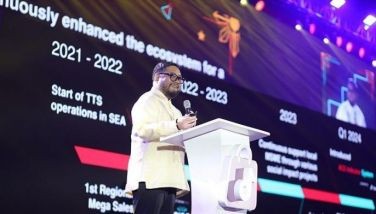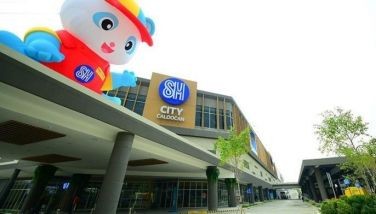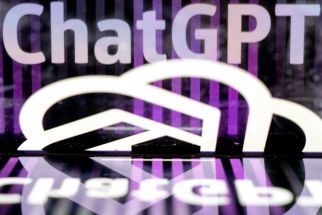Young techies featured at UP Ayala Technohub
Techno-inspired projects of students from the Department of Computer Science (DCS) and the Department of Electrical and Electronics Engineering (DEEE) of the UP Diliman’s College of Engineering were presented in an exhibition during the recent inauguration of the UP-AyalaLand Technohub.
DCS students had four projects on display: REALISM, TALa, TRACE, and KineSpell.
REALISM, which stands for Real-Time Hand Gesture Interface for Surgeons and Medical Experts, involves non-contact interaction in the operating room between the doctor and the computer used for studying images. Made by David Achacon Jr., Denise Carlos, and Maryann Puyaoan, REALISM enables the doctor to give image navigation commands to the computer using hand gestures.
Theft Alert for Laptops, or TALa, made by Shelah Castro, Karen Chua, and Melany Rosales, is a surveillance system that automatically detects laptop theft in offices and makes use of CCTV cameras already installed in the area.
REALISM and TALa are projects supervised by Prof. Christine Clarin and Dr. Prospero Naval Jr.
TRACE, on the other hand, is short for Tracking and Pose Recognitions of Adults in Health Care Environment.
A project by Alethea Carampel, Joanna Castillo, and Maria Franchesca Pituk, with Prof. Riza Navarro and Naval as faculty advisers, TRACE is an automated surveillance system ideal for hospitals and homes for the aged. Not only does it monitor patient activities, it also sounds an alarm should something happen to a patient, such as immobility or collapse.
KineSpell, the project of Ada Cariaga and Jay Salvador under their thesis adviser, Prof. Rowena Solamo, is an educational game that enhances the spelling skills of children.
It also provides an assessment of the player’s performance. The assessment includes the number of words spelled, number of mistakes, average mistakes per word, average time to spell a word, number of times a hint was used, and number of times the game was replayed.
DEEE projects featured at the Technohub launch included those of the Wireless Communication Engineering Library (WCEL), the Digital Signal Processing (DSP) Laboratory, and the Intel Microprocessors Laboratory (IML).
The WCEL is involved in the design, integration and analysis of wireless communication devices, circuits and systems.
“Practical Implementation of a Radio Frequency (RF) Spectrum Analyzer” by Fernando Bautista, Leonard Paet and Michelle Rosacay intends to provide a cost-effective alternative to expensive RF spectrum analyzers currently used by RF engineers. This project was done under the supervision of Dr. Joel Marciano.
The DSP, meanwhile, exhibited a project titled “Front-End Automatic Filipino Speech Recognition System,” which converts speech to text.
The system, which is in its initial phase, is currently compatible with Nokia mobile phones which have third edition Symbian operating systems such as the Nseries. College of Engineering Dean Rowena Guevara is the adviser of this project by Federico Ang.
It complements DSP’s much larger Filipino Speech Corpus project, which will help in the development of an automatic speech recognition system in Filipino. Some aspects of this system include transcription and translation.
The DSP is doing the project in collaboration with the Department of Filipino and the Department of Linguistics of UP Diliman.
Finally, the IML focuses on the development of new computer architectures. The laboratory has two major areas of research: the Reduced-Instruction-Set Computer (RISC) Core Development Program and the Radio Frequency (RF) Microelectronics Design Program.
The RISC Core Development Program aims to design, develop and implement new or specialized microprocessor architectures, with emphasis on efficient signal processing for mobile and low-power applications.
The RF Microelectronics Design Program, on the other hand, deals with the design, development and implementation of RF integrated circuits, with emphasis on new design techniques, device structures, circuit topologies, transceiver architectures, and building blocks in the multi-gigahertz range using standard digital CMOS processes.
The IML exhibited various microchips that were designed and manufactured by its students. Each microchip is an attempt to recreate and improve upon the design and function of microchips fabricated by large manufacturers.
These include “Design and Implementation of Low-Power CMOS Operational Amplifiers in a 0.25um Digital CMOS Process” by Alfonso Albason and Neil Axalan, under the supervision of Professors Richard Hizon, Theresa Gusad and Marc Rosales; “High-Level Implementation of the ARM7 Microprocessor” by Jonathan Delarmente, Lilibeth Gahol, and Erika Paragas, with advisers, Prof. Anastacia Ballesil and Hizon; “Design and Implementation of CMOS Rail-to-Rail Operational Amplifiers” by Arnold Manzano and Michael Lorenzo under Hizon, Rosales, and Gusad; and “Inductor Modeling Using 3D EM Design Tool for RF CMOS Process” by Gian Mayuga, with Rosales as adviser.
For the university, the facility is a learning laboratory — a place of learning and experimentation. “Something similar to Stanford University’s Silicon Valley or Route 128 of the Massachusetts Institute of Technology,” Ayala Corp. president Fernando Zobel de Ayala said.
- Latest






























